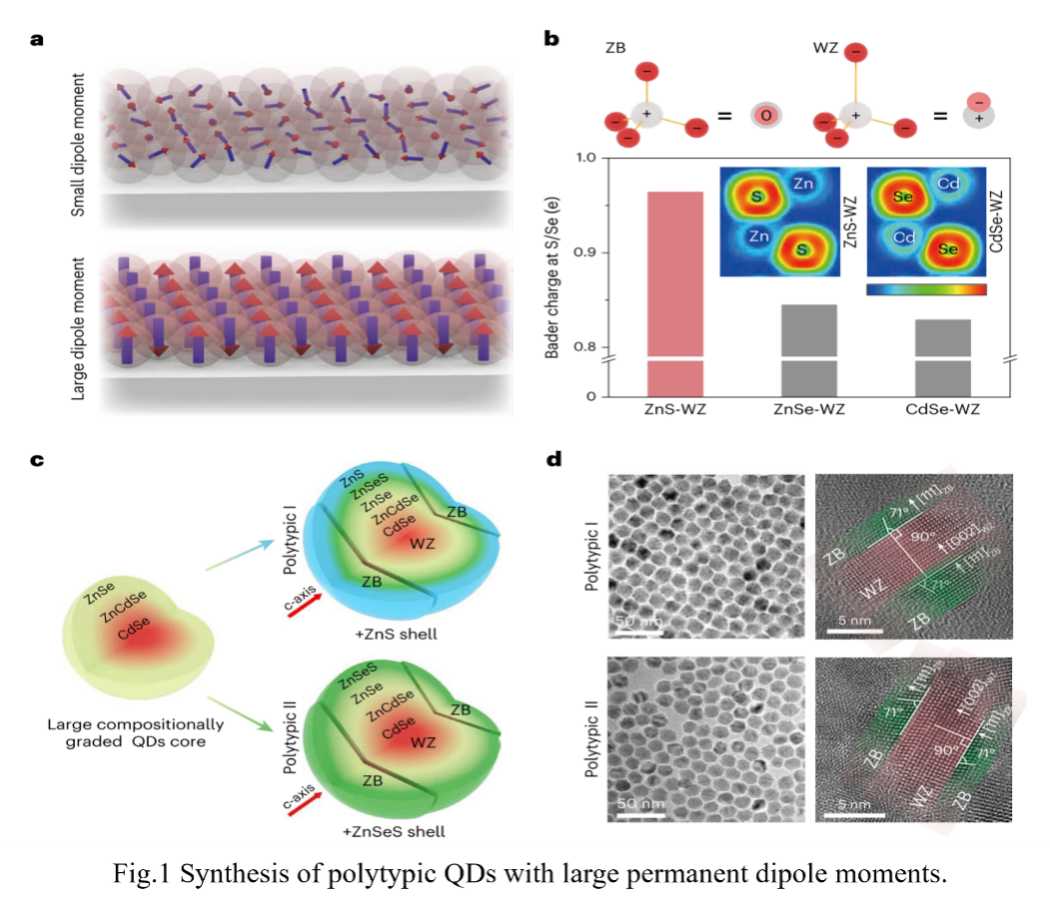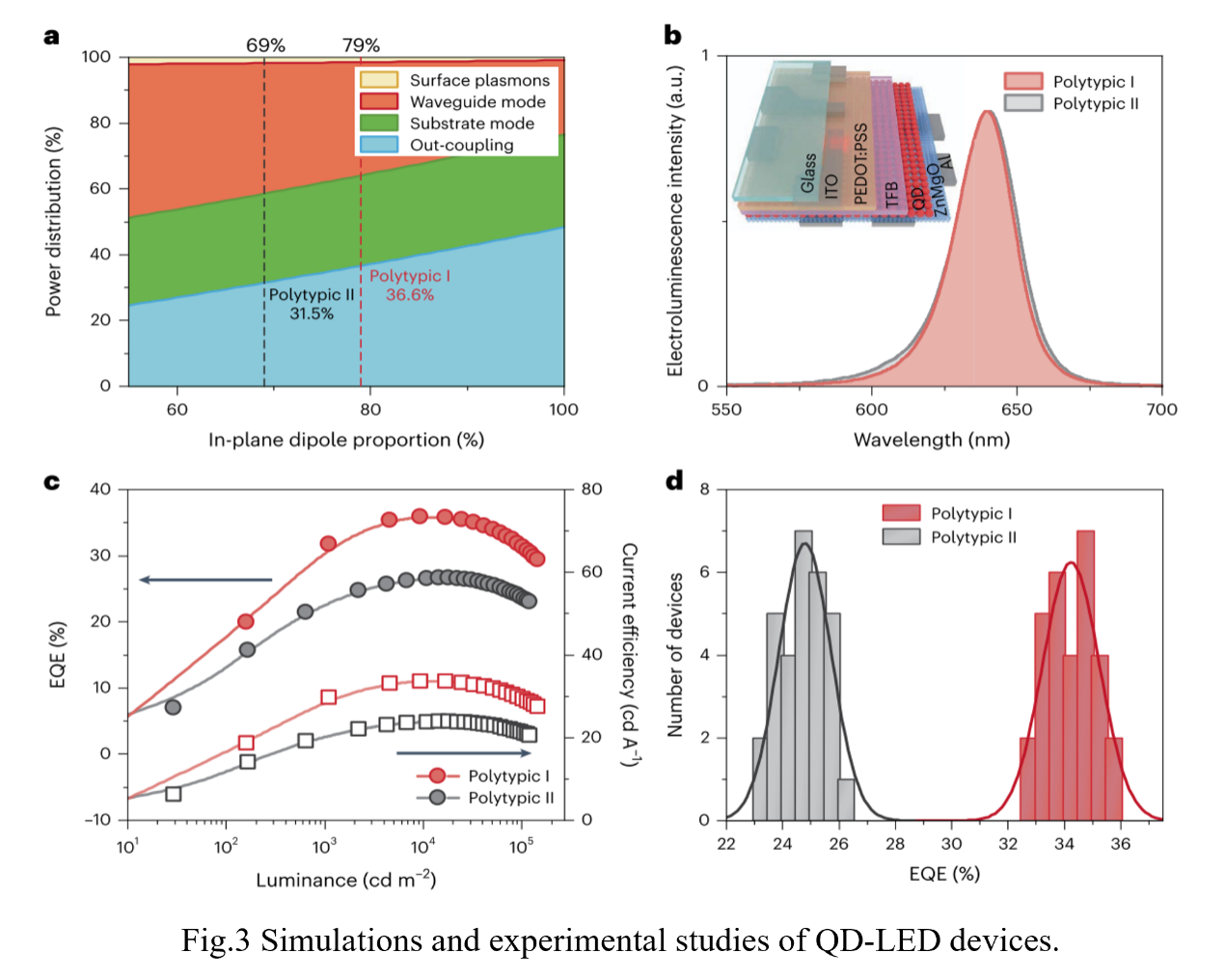Quantum dot(QD) light-emitting diodes (LEDs) have the advantages of wide color gamut coverage, low solution processing costs, and high brightness and efficiency at low voltages, are the strong competitor for the next generation of display technology. The luminous efficiency of quantum dot light-emitting diodes is a crucial performance indicator while improving internal quantum efficiency and external quantum efficiency are the two basic starting points for improving its luminous efficiency. External quantum efficiencies (EQEs) in QLEDs are now approaching the limits set by finite photon out-coupling: typically, fewer than 30% of generated photons escape, with the balance trapped inside devices. Arranging anisotropic quantum dots and controlling the transition dipole moment orientation in the quantum dots to increase photon emission perpendicular to the device substrate is an effective way to improve external coupling efficiency. However, the radiative recombination efficiency of LEDs using anisotropic quantum dot arrangements is low, and the increase in photon external coupling efficiency is offset by the loss of internal quantum efficiency. Therefore, it is necessary to find a feasible dipole orientation strategy to improve the external coupling efficiency without affecting the internal quantum efficiency.
In order to solve the above problems, Professor Huaibin Shen collaborated with Professor Fengjia Fan, Academician Jiangfeng Du and others from the University of Science and Technology of China, used the dipole-dipole interaction in mixed phase CdZnSeS quantum dots to effectively arrange the quantum dots and effectively enhance the photons in the light-emitting diode Outcoupling efficiency. This study developed a new type of polytype crystal structure quantum dots, using the wurtzite CdZnSe core as a structural template to epitaxially grow the wurtzite ZnS shell, obtained a polytype crystal with a wurtzite (WZ)/zinc blende (ZB) mixed-crystallographic phase quantum dots (Fig. 1). The strongly ionic wurtzite ZnS provides the large electric dipole moment required to arrange quantum dots; the zinc blende ZnS partially affects the electronic structure, thus promoting the oriented luminescence of each quantum dot, the two aspects are combined to realize the regulation of the transition dipole moment orientation. Back focal plane imaging and other methods confirmed the transition dipole moment orientation of this quantum dot material, which has an in-plane dipole moment ratio of 79 % (Fig. 2). QD-LED prepared by using these quantum dots exhibit ultrahigh efficiency and stability(EQEs up to 35.6 %, extrapolated T95 at 1,000 cd m–2 of over 40,000 h)(Fig. 3).



The research findings were published in the journal Nature Photonics under the title of "Dipole–dipole-interaction-assisted self-assembly of quantum dots for highly efficient light-emitting diodes". Huaiyu Xu (doctoral student at University of Science and Technology of China), Jiaojiao Song (doctoral student at Henan University), Penghao Zhou (master student at Henan University), Yang Song (doctoral student at University of Toronto), and Jian Xu (doctoral student at University of Science and Technology of China) are co-first authors; The corresponding authors are Huaibin Shen (professor at Henan University), Jiangfeng Du (academician at University of Science and Technology of China), Edward H. Sargent (professor at University of Toronto), and Fengjia Fan (professor at University of Science and Technology of China). This research work was supported by the National Natural Science Foundation of China, Innovation Program for Quantum Science and Technology, the National Key Research and Development Program of China, and the Henan University Youth Research Team Project.
Links to the papers: https://www.nature.com/articles/s41566-023-01344-4
Huaibin Shen is the winner of the National Outstanding Youth Fund, a distinguished professor of Henan Province, an outstanding expert of Henan Province, and a leading scientific and technological innovation talent in the Central Plains. He is mainly engaged in the research of quantum dot luminescent materials and electroluminescent devices, and has set international records for many key indicators such as brightness, efficiency, and lifetime of tri-primary color QD-LEDs; Professor Shen has published more than 160 SCI papers. In the past five years, as the first/corresponding author, he has published more than 40 SCI papers, including 2 Nat. Photonics, 1 Nat. Nanotechnol., 1 Nat. Commun., 5 Nano Lett. and 9 ESI highly cited papers. Professor Shen presided over 6 national-level projects including the National Key R&D Plan, the National Natural Science Foundation of China Regional Joint Fund Key Project, the National Natural Science Foundation of China-Outstanding Youth Project, etc. He has also authorized 23 national invention patents and 7 technology transfers; The results were selected into the "Top Ten Progress in Optics in China" and were selected into the National Natural Science Foundation of China briefing report for submission to the General Office of the CPC Central Committee and other central departments.

